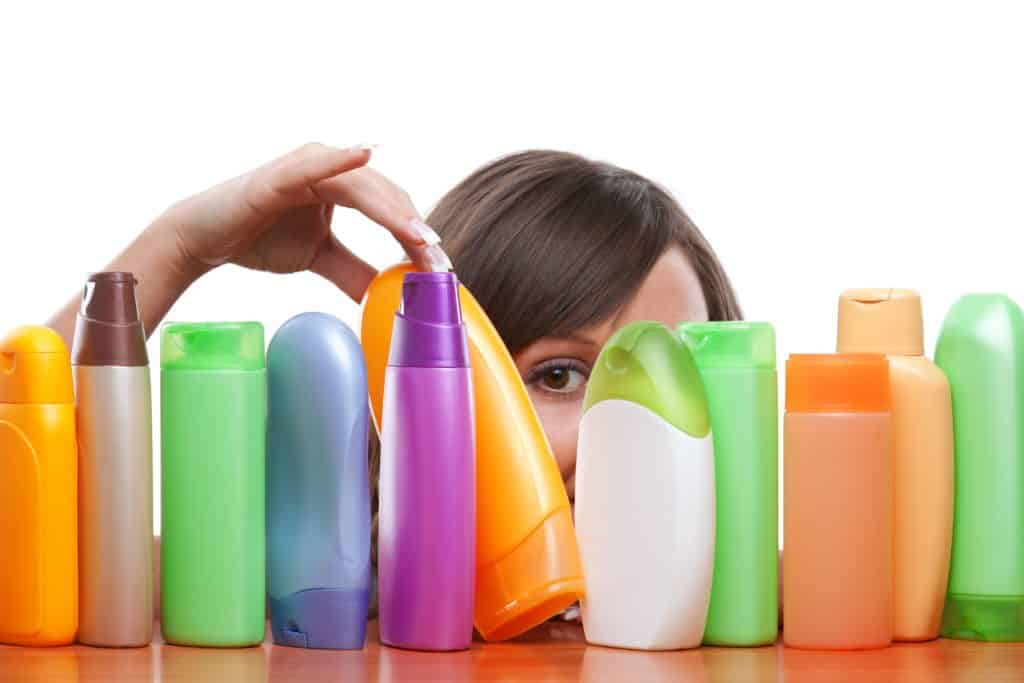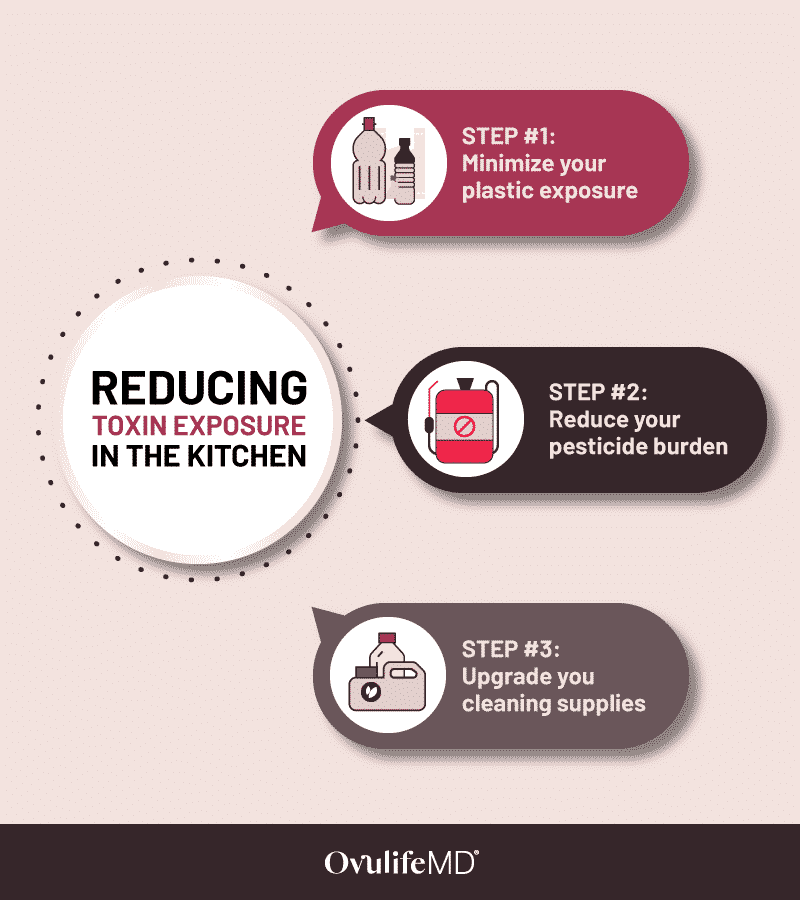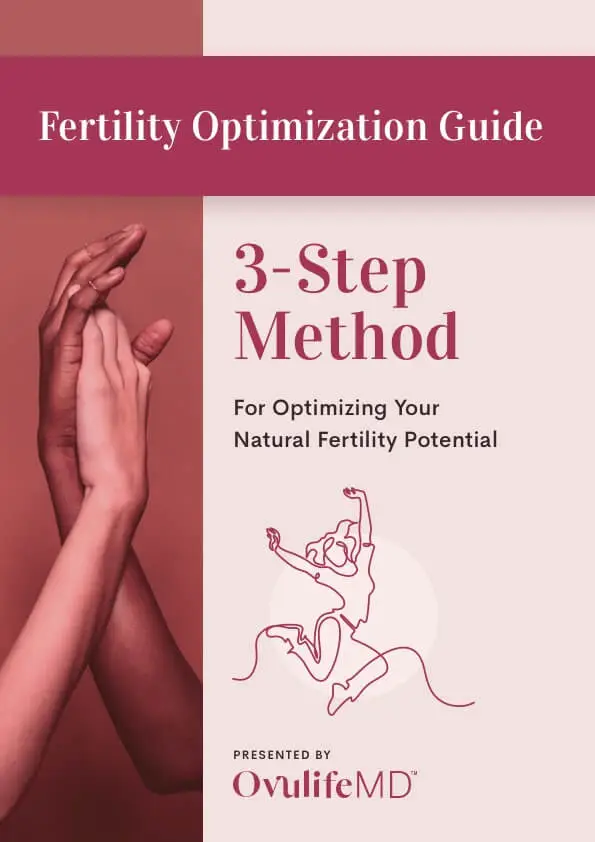
A woman’s body is exposed to as many as 500 different chemicals on a typical day – yikes!
And most of these found their way onto our bodies before we even left the house in the morning.
From our series on environmental toxins, you now know all the compelling evidence surrounding endocrine disruptors, pesticides, heavy metals AND your fertility.
So given the potential harms of these toxins on your reproductive health, how do you even begin reducing your exposure?
The most important thing is to start somewhere.
And because finding reliable and accurate information can be a HUGE barrier to making change, we wanted to share some of our favorite tools that have helped us along the way.
Here’s a quick overview of what you’ll discover:
How to detox your personal care products
Growing up, and quite frankly well into my 20’s, I never gave much thought to what products I used on my hair or body.
“Does it smell good? Great! It’s going in my cart.”
Now fast forward a few years as more and more data came out linking endocrine-disrupting chemicals (EDCs) to a whole host of adverse health effects that were related to my field of medicine… I knew I couldn’t ignore this topic anymore.
To get started, I started exploring the Environmental Working Group’s Skin Deep Database and downloaded the Healthy Living App.
With over 87,000 products tested in over 2,400 brands, just over 1,600 products are EWG Verified™ and the majority of products I was using at the time had been tested.
EWG verified™ products:
-
Adhere to the strictest standards for health
-
Avoid ingredients of concern, provide full transparency on the label
-
Use good manufacturing practices to ensure the safety of the product
Products are given a two-part score:
Part #1 = Hazard score. A scale based from 1-10 (1-2 being best or low hazard, and 7-10 being the worst or high hazard)
Part #2 = Available data. Presented from the most to the least evidence available.
So there it started… I began typing in all of my products… from my shampoo & conditioner, lotion, face cream, makeup, deodorant, and sunscreen… I was SHOCKED to see the scores of the products I was using. Here was the initial breakdown of my personal care products:
Face cleanser: 7
Shampoo & Conditioner: 7
Hair product (hair cream & mousse): 8 (!!)
Lotion: 6 or 8 depending on which one I used
Makeup: 1, 5 and 7 (depending on the product)
Sunscreen: 3
I suppose it could have been worse. But these scores seemed pretty terrible to me.
Quite honestly, after I looked it up, I closed my computer and ignored it for another week. Ignorance is bliss, right? But after a little bit of time, I knew I couldn’t ignore it any longer. If there was something better I could be doing for my health, I should be doing it, not ignoring it.
Slowly but surely, I started replacing each product one by one.
I learned the hard way that you can’t simply trust a label that promises “paraben, sulfate, phthalate-free” to not also have some hidden chemicals in there (I’m a sucker for good marketing). After a few failed attempts at products that were probably no better than what I started with, I ultimately used the same database to find EWG verified™ products, so I no longer had to worry about doing the research myself.
It’s important to note that I didn’t replace everything all at once.
A purge all and replace strategy didn’t seem practical. Not only would that have gotten expensive pretty quick, but it also seemed wasteful not to use up the remainder of the products in my cabinet (I know, I know).
But one by one, over the course of a few months, I transitioned to products that had the highest safety ratings, and I have to say, I felt really good about them.
My challenge for you: Check out your personal care products and see how they rank.
Don’t be overwhelmed or alarmed if you get scores like me. Knowledge is power. And now that you have the knowledge, you have the power to change it.
A good place to start is looking for fragrance-free, phthalate, paraben, and sulfate-free products. But remember, some labels can be sneaky, so be sure to check them out on the Environmental Working Group’s Skin Deep Database and or Healthy Living App before purchasing!
Three steps to drastically reduce toxin exposure in the kitchen
If you looked around my kitchen 10 years ago, you would most definitely find:
-
Prepackaged microwave-ready frozen meals wrapped in plastic
-
Plastic food storage and beverage containers
-
Conventional produce & meat
-
Standard cleaning supplies
Little did I know that all these things were potentially harming my health and fertility.
Here are some of the steps we recommend when it comes to reducing your toxin exposure in the kitchen:

Step #1: Minimize your plastic exposure
As you know from our post on endocrine-disrupting chemicals and pesticides, plastics such as bisphenol-A (BPA) have been adversely associated with reproductive outcomes.
And unlike my personal care products, it wasn’t such a sudden, in-my-face “ah-ha” moment when it came to potential toxins in the kitchen. The changes happened more slowly over time, which in hindsight was probably far less overwhelming than tackling everything at once.
-
First, as I was struggling with weight gain, I started learning to cook more for myself, which meant I had to say goodbye to prepackaged, plastic shrink-wrapped microwave meals (yes, even those “healthy, weight-loss” varieties. The less food heated in plastic the better.
-
Second, with increasing knowledge of BPA, I gradually swapped out my plastic food storage containers for glass storage containers. So when I went to reheat my yummy home-cooked leftovers, I had the opportunity to reduce my BPA exposure yet again.
-
Third, I invested in a stainless steel travel coffee mug and water bottle (best investments EVER!)
Those three changes alone nearly eliminated all my exposure to BPA in the kitchen.
Step #2: Reduce your pesticide burden
Do I really need to buy organic everything?
This is a common question we get asked.
And the short answer is, if you have the ability to purchase high quality, organic foods (produce, meats, grains and the like) then that is probably the safest thing to do.
If you’re like me and quite frankly didn’t have the option to go completely organic when getting started, then swapping out the top offenders is a great place to start, and will make a BIG difference!
Remember back in the pesticide post when we talked about the Dirty Dozen (the top 12 fruits and vegetables with the highest levels of pesticide residues on them)…
Well, we always recommend focusing on the Dirty Dozen when starting to go organic – this will definitely get you the biggest bang for your buck.
I used to eat at least 6 of the dirty dozen foods on a daily basis. By going organic with those fruits and veggies, I now enjoy the same foods while feeling confident about drastically reducing my pesticide exposure.
With that said, when it comes to the Clean Fifteen, I am a little more lenient and will buy organic only if it’s on sale or the quality looks better than the conventional options.
Having trouble remembering which produce is on what list? Don’t forget to download the app or just take a screenshot and save it to your favorite photos for quick reference in the store!
When Will buys meat, he looks for organic, grass-finished products as we know pesticide exposure doesn’t just occur on the surface of produce. Local farmer’s markets are a great place to start for this as you will often have far better sourcing and a better price.
When it comes to plant-based proteins, I tend to go completely organic as well simply because I eat so much of them.
Step #3: Upgrade your cleaning supplies
When it comes time to clean up the mess, how bad can it be?
Much like your personal care and beauty products, cleaning products can be wrought with those same endocrine-disrupting chemicals (fragrances, parabens, and the like).
With the lengthy ingredients lists, sorting out the impact of each cleaning product on your fertility could take quite some time.
To be honest, there simply isn’t much research on cleaning products and fertility-related outcomes at this point, but from what we know about some of the individual ingredients within cleaners (much like beauty products) avoiding exposure is a win.
First, reference the EWG Cleaning Guide to see where your cleaning products fall on the scale.
Next, take a look at some “greener” alternatives and invest in swapping out your most commonly used product to start – we love products by Puracy. If you have some products you just love too much and can’t give up, be sure to wear rubber gloves to reduce exposure.
Lastly, if you’re ready to get creative, some of our favorite “green cleaners” are actually homemade. Try this do-it-yourself cleaning solution:
White vinegar + Lemon juice + Water
The best part about homemade cleaning solutions… they can be used on a variety of surfaces (just not natural stone — learned this the hard way!) and they are much cheaper than the store-bought versions.
Filtering toxins from your water
You know how we feel about beverages and fertility and that water is hands down the best source of hydration, but what we haven’t talked about is that the quality of your water may also matter.
I grew up drinking tap water so it never really occurred to me that what’s in our water might be a problem. After all, there wasn’t a sign on my sink that said “non-potable” or “don’t drink.” It should be obvious, right?
According to data collected by the EWG, more than 250 contaminants have been found in our nation’s water supplies, 45 of which have been linked to hormonal disruption, and 28 which have been connected to fertility problems.
We started by entering our zip code on EWG’s Tap Water Database.
Where I was living at the time, it had 28 total contaminants, 14 of which exceeded EWG health guidelines (including arsenic, nitrates, nitrites, and chloroform among many other heavy metals).
Needless to say, I promptly bought a water filter.
While there are MANY fancy varieties out there, Will and I love our ZeroWater Filter.
It’s affordable, large enough for two of us (23 cups- although we have since bought 2 and keep them side by side in the refrigerator) and works via a 5-stage water filtration system that takes care of our highest concerns.
Plus, the water tastes great, so you can finally stop buying those reusable plastic water bottles once and for all (double-win!).
Yes, technically the water storage compartment for this filtration system is BPA-free plastic, but we let this slide as it’s stored in the fridge, reducing the potential for any plastic leaching. You can always go with an industrial steel design, such as those made by Berkey.
Final Thoughts:
When it comes to removing fertility threats, it’s important to go one by one and not get overwhelmed. Trying to tackle everything all at once can be a recipe for disaster.
-
Research your top 3 daily beauty products and see where they rank – if of higher toxin potential swap them out for greener alternatives
-
Swap out plastics in the kitchen – choose your top 3 sources of plastic exposure in the kitchen and make the switch!
-
Thinking about the top 3 fruits and vegetables you eat most- if on the Dirty Dozen list, try purchasing organic
-
Check out your cleaning products- wear protective gloves when cleaning, or go homemade with basic ingredients if you can
-
Invest in a good water filter
Maybe this month you tackle one of these tasks and next month is another. The important thing is to start somewhere. Small changes over time will add up to something big.
P.S. Don’t forget to check out our individual posts about each of the top 3 environmental toxins threatening your fertility if you haven’t already!
If you enjoyed this post, get more like it
Always evidence-based. Always actionable.
And just like a good doctor’s visit, your privacy is protected
Don't worry, you can always unsubscribe with just one click.Welcome to the tribe!
You’ve joined the OvulifeMD community. Don’t forget to check your inbox for a special welcome email.
Featured Content



Leave a comment
If you have any questions, we will be happy to answer them.
Thanks for sharing what's on your mind!
Check the thread for more insight and support.